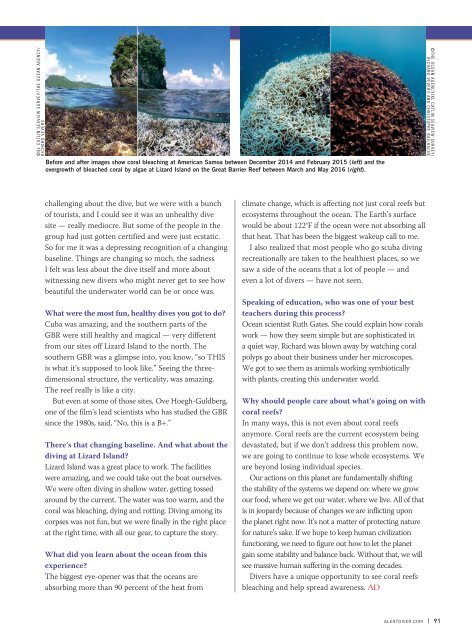AD 2017 Q4
Alert Diver is the dive industry’s leading publication. Featuring DAN’s core content of dive safety, research, education and medical information, each issue is a must-read reference, archived and shared by passionate scuba enthusiasts. In addition, Alert Diver showcases fascinating dive destinations and marine environmental topics through images from the world’s greatest underwater photographers and stories from the most experienced and eloquent dive journalists in the business.
Alert Diver is the dive industry’s leading publication. Featuring DAN’s core content of dive safety, research, education and medical information, each issue is a must-read reference, archived and shared by passionate scuba enthusiasts. In addition, Alert Diver showcases fascinating dive destinations and marine environmental topics through images from the world’s greatest underwater photographers and stories from the most experienced and eloquent dive journalists in the business.
Create successful ePaper yourself
Turn your PDF publications into a flip-book with our unique Google optimized e-Paper software.
©XL CATLIN SEAVIEW SURVEY/THE OCEAN AGENCY/<br />
RICHARD VEVERS<br />
Before and after images show coral bleaching at American Samoa between December 2014 and February 2015 (left) and the<br />
overgrowth of bleached coral by algae at Lizard Island on the Great Barrier Reef between March and May 2016 (right).<br />
Ƒ©THE OCEAN AGENCY/XL CATLIN SEAVIEW SURVEY/<br />
RICHARD VEVERS AND CHRISTOPHE BAILHACHE<br />
challenging about the dive, but we were with a bunch<br />
of tourists, and I could see it was an unhealthy dive<br />
site — really mediocre. But some of the people in the<br />
group had just gotten certified and were just ecstatic.<br />
So for me it was a depressing recognition of a changing<br />
baseline. Things are changing so much, the sadness<br />
I felt was less about the dive itself and more about<br />
witnessing new divers who might never get to see how<br />
beautiful the underwater world can be or once was.<br />
What were the most fun, healthy dives you got to do?<br />
Cuba was amazing, and the southern parts of the<br />
GBR were still healthy and magical — very different<br />
from our sites off Lizard Island to the north. The<br />
southern GBR was a glimpse into, you know, “so THIS<br />
is what it’s supposed to look like.” Seeing the threedimensional<br />
structure, the verticality, was amazing.<br />
The reef really is like a city.<br />
But even at some of those sites, Ove Hoegh-Guldberg,<br />
one of the film’s lead scientists who has studied the GBR<br />
since the 1980s, said, “No, this is a B+.”<br />
There’s that changing baseline. And what about the<br />
diving at Lizard Island?<br />
Lizard Island was a great place to work. The facilities<br />
were amazing, and we could take out the boat ourselves.<br />
We were often diving in shallow water, getting tossed<br />
around by the current. The water was too warm, and the<br />
coral was bleaching, dying and rotting. Diving among its<br />
corpses was not fun, but we were finally in the right place<br />
at the right time, with all our gear, to capture the story.<br />
What did you learn about the ocean from this<br />
experience?<br />
The biggest eye-opener was that the oceans are<br />
absorbing more than 90 percent of the heat from<br />
climate change, which is affecting not just coral reefs but<br />
ecosystems throughout the ocean. The Earth’s surface<br />
would be about 122°F if the ocean were not absorbing all<br />
that heat. That has been the biggest wakeup call to me.<br />
I also realized that most people who go scuba diving<br />
recreationally are taken to the healthiest places, so we<br />
saw a side of the oceans that a lot of people — and<br />
even a lot of divers — have not seen.<br />
Speaking of education, who was one of your best<br />
teachers during this process?<br />
Ocean scientist Ruth Gates. She could explain how corals<br />
work — how they seem simple but are sophisticated in<br />
a quiet way. Richard was blown away by watching coral<br />
polyps go about their business under her microscopes.<br />
We got to see them as animals working symbiotically<br />
with plants, creating this underwater world.<br />
Why should people care about what’s going on with<br />
coral reefs?<br />
In many ways, this is not even about coral reefs<br />
anymore. Coral reefs are the current ecosystem being<br />
devastated, but if we don’t address this problem now,<br />
we are going to continue to lose whole ecosystems. We<br />
are beyond losing individual species.<br />
Our actions on this planet are fundamentally shifting<br />
the stability of the systems we depend on: where we grow<br />
our food, where we get our water, where we live. All of that<br />
is in jeopardy because of changes we are inflicting upon<br />
the planet right now. It’s not a matter of protecting nature<br />
for nature’s sake. If we hope to keep human civilization<br />
functioning, we need to figure out how to let the planet<br />
gain some stability and balance back. Without that, we will<br />
see massive human suffering in the coming decades.<br />
Divers have a unique opportunity to see coral reefs<br />
bleaching and help spread awareness. <strong>AD</strong><br />
ALERTDIVER.COM | 91









